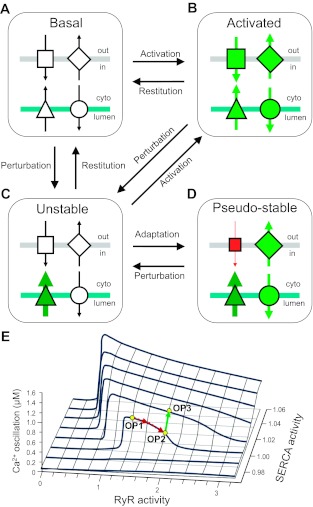Fig. 2.
System balance, homeostasis, and activation: the emergence of pseudo-stable states via functional (mal)adaptation. Using a simplified scheme of four components in the surface membrane (gray bar) and SR (blue bar) that mediate directional ion flux (arrows), we show that the proper transition from the basal state (A) to the fully activated state (B) depends on the synchronization of all components. The isolated perturbation of a single component in this system (triangle) normally leads to a transiently unstable state (C) that is either restored to the basal state (by subsequent modulation of this component) (A) or exists as an acute intermediate step en route to full activation (B). However, under some circumstances (e.g., persistent changes in abundance or activity of a component), functional adaptation renders the system functionally rebalanced such that it appears stable (D). This rebalanced state (illustrated here as a compensatory reconfiguration of ion fluxes) is fundamentally different from the basal (homeostatic) state (A). We term the state depicted in D as a pseudo-stable state. Black = basal activity, red = reduced activity, green = augmented activity. E: the emergence of pseudo-stable states through functional (mal)adaptation was tested by the mathematical model of cellular Ca2+ cycling described in Fig. 1B. We modeled the functional relationship between the SERCA pump and the ryanodine-sensitive Ca2+-induced Ca2+ release mechanism by plotting a family of bifurcation diagrams (as in Fig. 1B) for increasing values of SERCA pump activity. Increasing the activity of RyR2 shifts the oscillatory activity from an assumed “normal” operating point (OP1) to a suboptimal level of activity defined as OP2 (red arrow). Compensatory upregulation of the SERCA pump is potentially able to restore the amplitude of Ca2+ oscillations to its original level, thus reaching a new stable operating point (OP3, green arrow). The text section Towards an Understanding of Reduced Dynamic Range, Maladaptation, and the Disease-Linked Network State describes OP3-like scenarios that are characterized by apparently normal phenotype but are underscored by fundamentally different network properties (44).

